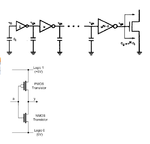rshrivas
Newbie level 4
I am designing a NOT gate chain to drive a NMOS switch. The NOT gate is made up of one PMOS between the vdd and o/p and a NMOS between op and gnd..
I need to find out the value of input and output capacitance of the NOT gate..
The strategy I am using is to find Cgg and Cdd for both the NMOS and PMOS and then adding Cggpmos + Cggnmos and using it as input capacitance.. Similarly using Cdd of PMOS and NMOS together and adding them together to get the output cap...
Kindly let me know if my strategy is correct....
I need to find out the value of input and output capacitance of the NOT gate..
The strategy I am using is to find Cgg and Cdd for both the NMOS and PMOS and then adding Cggpmos + Cggnmos and using it as input capacitance.. Similarly using Cdd of PMOS and NMOS together and adding them together to get the output cap...
Kindly let me know if my strategy is correct....
